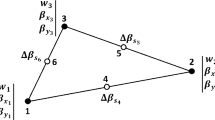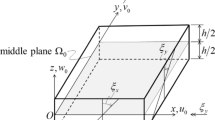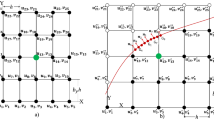Abstract
In this article we focus on the approximation of the Reissner–Mindlin (R–M) plate model by high-order p and hp versions of the Finite Element Method (FEM), in the case when the mesh includes curved elements; this is of particular interest when plates with smooth boundary are considered. Our main goal is to verify that an appropriately defined Mixed Interpolated Tensorial Components (MITC) FEM performs well, in the presence of curved elements, when the energy norm is used as an error measure, as well as when quantities of engineering interest are computed. Comments on the performance of the standard FEM formulation are also made
Similar content being viewed by others
References
Ainsworth M., and Pinchedez K. (2002). hp-MITC finite element method for the Reissner-Mindlin plate problem. J. Comp. Appl. Math. 148:429–462
Arnold D., and Falk S. (1989). Edge effects in the Reissner-Mindlin plate theory. In Noor A.K., Belytschko T., and Simo J.C (eds). Analytic and Computational Models of Shells. A.S.M.E., New York, pp. 71–90
Brezzi F., Bathe K.J., and Fortin M. (1989). Mixed-interpolated elements for Reissner-Mindlin plates. Int. J. Numer. Methods Engrg. 28:1787–1801
Chilton L., and Suri M. (2000). On the construction of stable curvilinear p version elements for mixed formulations of elasticity and Stokes flow. Numer. Math. 86:29–48
Kurtz J. (2002). A p-version Finite Element Method for Shear Force Computation in Reissner-Mindlin Plates with Curved Boundary. M.Sc. Thesis, Department of Mathematics and Computer Science, Clarkson University, Potsdam, NY
Kurtz J., and Xenophontos C. (2003). On the effects of using curved elements in the approximation of the Reissner-Mindlin plate by the p version of the finite element method. Appl. Num. Math. 46:231–246
Rank E., Krause R., and Preusch K. (1998). On the accuracy of p-version elements for the Reissner-Mindlin plate model. Int. J. Numer. Meth. Engrg. 43:51–67
Schwab Ch., Suri M., and Xenophontos C. (1998). The hp finite element method for problems in mechanics with boundary layers. Comput. Methods Appl. Mech. Engrg. 157:311–333
Stenberg R., and Suri M. (1997). An hp error analysis of MITC plate elements. SIAM J. Num. Anal. 34:544–568
Suri M. (1996). Analytic and computational assessment of locking in the hp finite element method. Comput. Meth. Appl. Mech. Engrg. 133:347–371
Suri M., Babuška I., and Schwab C. (1995). Locking effects in the finite element approximation of plate models. Math. Comp. 64:461–482
Szabó, B., and Babuška, I. (1991). Finite Element Analysis, Wiley
Xenophontos, C., Kurtz, J., and Fulton, S. R. (2003). A hp MITC finite element method for Reissner-Mindlin plates with smooth boundaries, Technical Report 2003–01, Department of Mathematical and Computer Science, Clarkson University
Author information
Authors and Affiliations
Corresponding author
Rights and permissions
About this article
Cite this article
Xenophontos, C. The Use of Curved Elements in the Finite Element Approximation of Thin Plates by High Order p and hp Methods. J Sci Comput 27, 465–476 (2006). https://doi.org/10.1007/s10915-005-9053-9
Received:
Accepted:
Published:
Issue Date:
DOI: https://doi.org/10.1007/s10915-005-9053-9
Keywords
Profiles
- Christos Xenophontos View author profile




